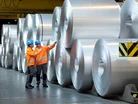Aluminum Association Lays out North America GHG Roadmap

The aluminium industry in North America has laid out strategies to slash greenhouse gas (GHG) emissions in line with wider net zero goals.
The Aluminum Association report – Pathways to Decarbonisation: A North American Aluminum Roadmap – lays out pathways to achieve industry-wide carbon emission reductions in line with International Energy Agency’s Net Zero 2050 goals.
The report finds North America has an aluminium-product carbon footprint that is about 50% lower than global averages.
This is attributed to the use of low-carbon primary aluminium, increased recycling and voluntary emissions reductions efforts over the past several decades.
But the report says that, despite this, meeting such onerous emissions reductions targets by 2050 will require an “all-of-society approach to decarbonisation and tens of billions of dollars in both public and private investment”.
Analysts estimate it will take approximately US$1tn across the global primary production value chain – mostly in power supply and smelters – to meet global aluminium net-zero climate goals by 2050.
Aluminium 2050 net zero targets
According to the roadmap laid out in the report, achieving net zero targets will require aluminium production emissions reductions of 24% by 2030, 63% by 2040 and 92% by 2050 (compared to a 2021 emissions baseline).
Output is projected to increase by around 80% during this period, driven by growing demand for the metal to support sustainability efforts in various sectors.
The roadmap identifies several pathways that it says will help the industry reach the 2050 targets. These include:
- New primary aluminium production technologies, such as inert anode smelting and energy efficiency improvements at plant level.
- Transition to new energy sources, like green hydrogen, and the electrification of furnaces.
- Deployment of clean energy technologies to decarbonise the US electric grid.
The report says that, in total, about one-third of the required emissions reductions can come from aluminium production technology improvements over which the industry has most control.
The other two-thirds it says must come from “a combination of newly developed, affordable manufacturing technologies”.
Also necessary, it stresses, will be “deployment of state and federal research and infrastructure investment” and a national policy “that supports the clean energy transition”.
“Our industry is proud of the vital role we play in the clean energy transition and the strides we’ve made to reduce carbon emissions over the last several decades,” says Charles Johnson, president & CEO of the Aluminum Association.
He adds: “Average carbon emissions to produce a pound of aluminium in North America has dropped by more than half since 1991, giving us a significant head start over the rest of the world and an opportunity to lead the way producing lower carbon metal. But we know that much more must be done to meet net zero targets by 2050.”
- BYD’s Blade Battery: Reducing Reliance on Nickel and CobaltSustainability
- Anglo American and Teck: Forming a Global Minerals GiantSupply Chain & Operations
- Maaden Appoints Donovan Waller to Lead Mining Tech FutureTechnology
- IEF on 'Paradox' of Mining's Role in Quest for Clean EnergySustainability



